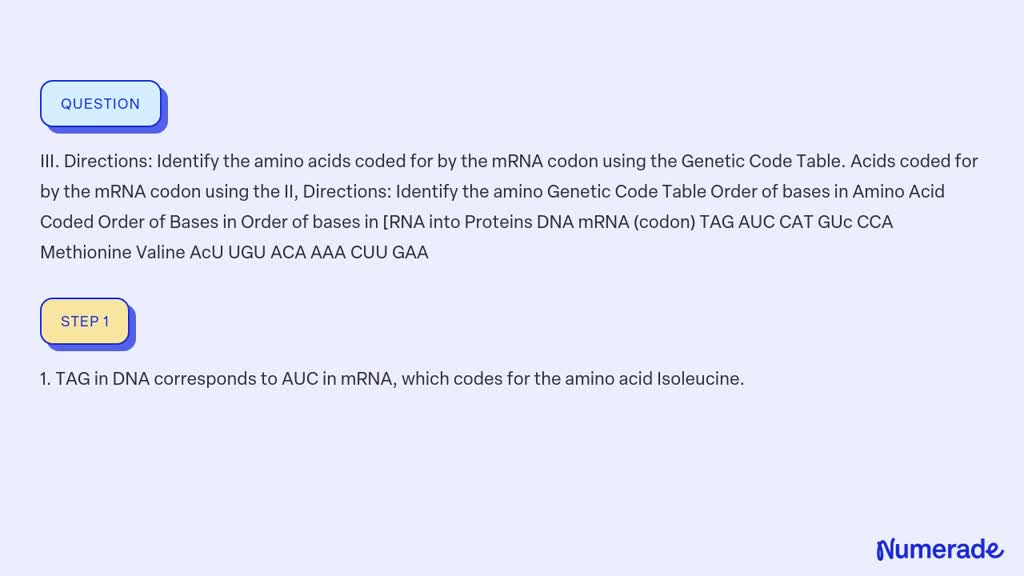
The fundamental unit of life, the cell, operates with an extraordinary molecular language spoken by sequences of nucleotides. One of the most intriguing aspects of this intricate language is the translation of these sequences into amino acids, the building blocks of proteins. Within this context, the codon “AUG GUC GGU” serves as a fascinating case study. In this article, we will meticulously explore the significance of these codons, elucidate the amino acids they encode, and delve into the consequential ramifications of this knowledge.
The journey into the world of genetic sequences begins with an understanding of the genetic code itself. It is a triplet code, meaning that every three nucleotides correspond to a specific amino acid or a stop signal during protein synthesis. Each amino acid is represented by a unique codon, which comprises three nucleotides. With 64 possible codons—derived from four nucleotides (adenine, cytosine, guanine, and uracil in RNA)—there are only 20 amino acids. This redundancy in the genetic code is a testament to the complexity and resilience of biological systems.
The codon “AUG” is particularly noteworthy as it plays dual roles: it encodes for the amino acid methionine and serves as the start codon for translation. Methionine holds a unique place as it is the first amino acid incorporated into polypeptide chains during protein synthesis in eukaryotes, marking the commencement of translation. The presence of methionine is crucial for proper protein synthesis, ensuring that the ribosome recognizes where to begin reading the messenger RNA (mRNA) sequence.
Following the enigmatic AUG, we encounter “GUC.” This codon translates to the amino acid valine. Valine, classified as a branched-chain amino acid (BCAA), plays a vital role in muscle metabolism and energy production. It is particularly significant for athletes and individuals engaged in rigorous physical activity, as it aids in muscle recovery and growth. The presence of valine in proteins contributes not only to structural properties but also to metabolic functions that are essential for cellular health.
Finally, we arrive at the codon “GGU,” which encodes for the amino acid glycine. Glycine is the simplest amino acid, characterized by its single hydrogen atom as its side chain. Despite its simplicity, glycine possesses profound biochemical significance, functioning as a critical component in the synthesis of proteins, neurotransmitters, and nucleic acids. Its unique properties allow it to stabilize protein structures and facilitate flexibility, particularly in collagen, the most abundant protein found in the human body.
Delving deeper into the implications of these amino acids encoded by “AUG GUC GGU,” one recognizes the interdependence present in protein synthesis. Each amino acid introduces specific characteristics, contributing to the overall functionality and structural integrity of proteins. Proteins can serve as enzymes, hormones, structural components, or even signaling molecules, emphasizing the notion that the minutiae of our genetic code direct the grand narrative of life itself.
The process of translation begins with the assembly of the ribosome at the start codon, AUG. Transfer RNA (tRNA) plays an indispensable role, as it carries the respective amino acids to the ribosome in a manner dictated by the anticodon sequence that complements the mRNA codons. Hence, the tRNA specific to methionine will recognize AUG, valine’s tRNA will match with GUC, and glycine’s tRNA will pair with GGU. The ribosome orchestrates this assembly with remarkable precision, catalyzing peptide bond formations between successive amino acids, ultimately resulting in a nascent polypeptide chain.
As we expand our understanding of these codons, it becomes increasingly apparent that the study of genetic sequences is rife with opportunities to influence medicine, biotechnology, and evolutionary biology. By deciphering how specific codon sequences dictate the translation of particular amino acids, scientists develop targeted therapies aimed at correcting genetic disorders caused by mutations in these sequences. Moreover, the manipulation of genetic codes has far-reaching implications for advancements in synthetic biology, where engineered organisms harness unique protein functions to address various challenges, from renewable energy production to disease resistance in crops.
The exploration of genetic sequences is not merely an academic endeavor; it invites us to consider the very essence of life. Each codon function provides insight into the interconnectedness of biological processes and hints at the evolutionary pathways that shaped life on Earth. The intricate dance of codons, amino acids, and resulting proteins sheds light on the mechanisms of heredity, adaptation, and even the enigma of complex behaviors.
In conclusion, the codon sequence “AUG GUC GGU” exemplifies the magnificence of genetic coding and protein synthesis. The journey of decoding these sequences reveals the foundational elements of life while provoking curiosity about the ongoing mechanisms of biological regulation and expression. The knowledge gleaned from understanding how these amino acids contribute to protein functionality fosters a greater appreciation for the symphony of molecular interactions that sustain life as we know it. As our understanding deepens, we stand on the precipice of groundbreaking advancements, poised to unlock the mysteries that encode not just amino acids but the very fabric of life itself.
